General information
Not everyone knows that window fittings have 3 modes:
- Summer. Minimum sash pressure, slight drafts are possible. But the service life of the rubber seal increases.
- Winter. Maximum pressure. If the position remains the same all year round, the seal will quickly become unusable.
- Universal. The pressure is less than in winter, but more than in summer. Neutral mode does not require adjustment for the first years after installation.
A special adjusting screw is responsible for the tightness of the fit, the appearance of which varies among different manufacturers. Most often, a dot or mark is applied to the eccentric, which shows how much the door touches the frame:
- in the neutral position, the trunnion looks up or down,
- in the summer – to the street,
- in the winter – into the apartment.
There are also oval-shaped bolts: usually in winter they are vertical, in summer – horizontal, in the off-season – diagonally.
Adjustment for summer
In order to adjust plastic windows yourself before summer, first you need to open the sash and look at the eccentrics located where the shutter adjoins the impost.
Next, select a tool suitable for adjusting the fittings:
- A hex key;
- A flat or Phillips screwdriver;
- pliers.
Most often, you need a hex key.
Let’s start adjusting:
- using a suitable tool, turn all the trunnions with the score line towards the street (or set the oval ones to the horizontal position);
- close the plastic window;
- done!

Adjustment for winter
A strong fit of the window sash to the frame characterizes the winter mode. To achieve a tight fit, you will need a suitable tool (screwdriver, key, pliers). Rotate the eccentrics counterclockwise for the left transom or clockwise for the right one — the point should look inside the apartment. To adjust the oval pivot, rotate it to the vertical post.
You can check how the sash pressure adjustment is done using a sheet of paper:
- Open the window.
- Insert the sheet between the door and the impost.
- Close.
- Pull the sheet.
If the paper is held tightly and does not come out, the plastic window is adjusted correctly. If the sheet can be pulled out of the closed frame, other fittings need to be adjusted: we will talk about them in the following sections.
Important! The service life of the window in winter mode should be shorter than in summer. It is best to install it only when there is snow outside. And remove it when it starts to melt. If the draft is too strong in summer mode, switch the eccentrics to the neutral position during the change of seasons (spring, autumn).
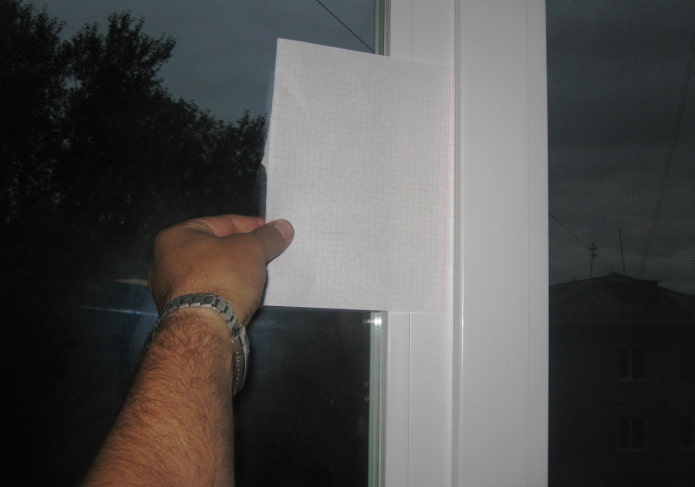
How to adjust so that there is no draft?
It happens that a plastic window is set to winter mode, but there is still a draft. The methods for correcting the problem depend on the cause:
- Inappropriate mode. In the summer and neutral positions of the eccentrics, the window may be blown. How to switch a PVC window to winter mode is described in the previous section.
- A damaged seal. The rubber could have worn out if the window was in the “Winter” mode for a long time or it is simply old. For better sealing, it is recommended to replace the seal around the entire perimeter of the sashes.

- Poor installation. It is quite difficult to correct this error made during installation with your own hands. In case of incorrect installation, air can blow from the hinges, the places where it adjoins the slopes and the window sill, along the glass contour (under the glazing beads), or the handle mechanism. To solve this problem, contact trusted specialists.
- Sagging sash. In addition to eccentrics, a plastic window also has other adjustable fittings: upper and lower hinges, locks, switches, strike plates. Turning them helps to achieve a tighter closing.
Horizontally
The sash of a plastic window is adjusted left-right and up-down using a hex key.
Tip! Since there are many hard-to-reach places in PVC windows, it is most convenient to work with a tool with a rounded head when adjusting.
To adjust the position of the movable part relative to the frame by 1, 2 mm to the left or right, first adjust the lower canopy. To do this, insert the Allen key into the side groove and turn:
- Clockwise to pull the movable part toward the hinge.
- Counterclockwise to move the door away from the frame.
Turning the top hinge allows you to adjust the position of the sashes by up to 4 mm. To do this, open the window, insert the key into the appropriate side hole from the inside.
- Turning clockwise pulls the movable part of the window toward the hinge, raises the opposite lower corner.
- Counterclockwise rotation, on the contrary, pushes away, lowers the bottom.
Important! The units should be turned minimally: if you overdo it, the corners will start to catch the frame when opening and closing the window.
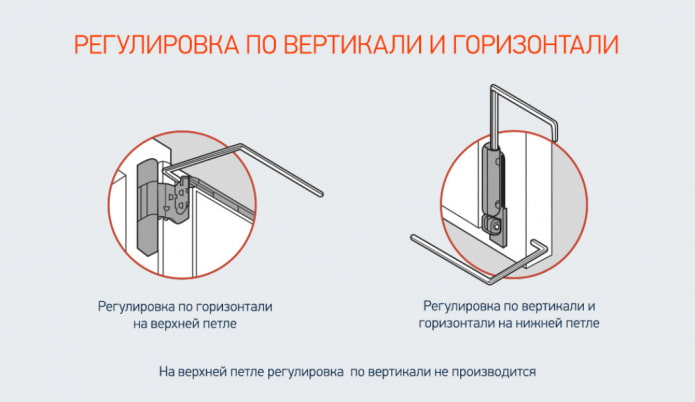
Vertical
Most often, the vertical position needs to be corrected. The adjustment unit is located in the lower hinge; to get to it, you need to remove the protective cap: on the upper end you will see a suitable hole for a hexagon.
The up-down stroke is about 2-2.5 mm in height in either direction. To raise the door, turn it clockwise; to lower it, turn it counterclockwise.
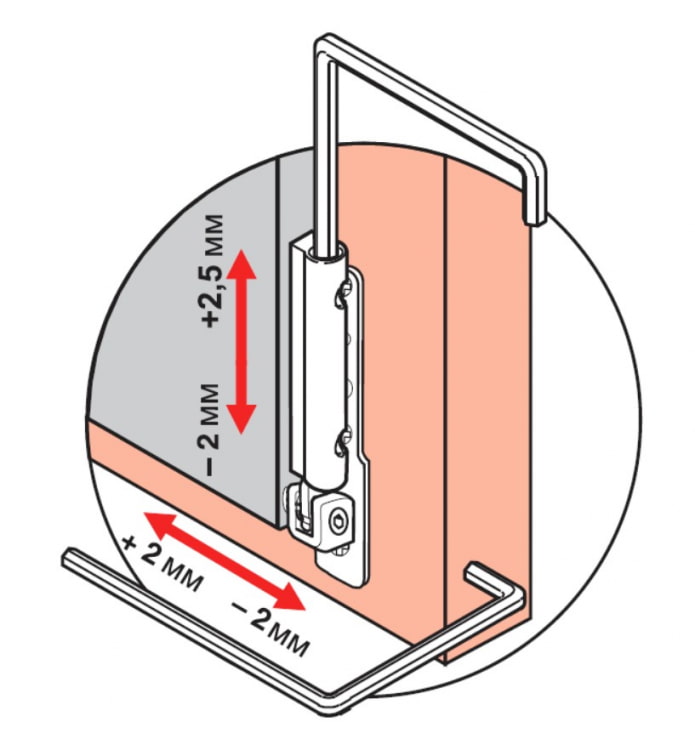
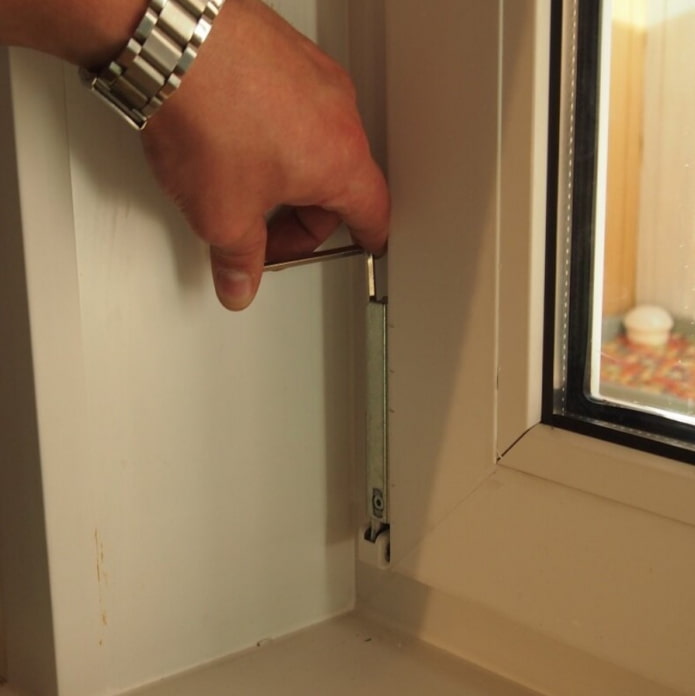
What to do if it is difficult to close?
PVC doors and windows are a complex mechanism consisting of many elements. If all the parts are not properly looked after and regular maintenance is ignored, problems may begin over time. The most common of them is a tight movement. This is most noticeable when closing the window after ventilation mode: you simply cannot turn the handle all the way.
To prevent the window from jamming at the most inopportune moment – winter cold or summer heat, do not postpone solving the problem: start adjusting it immediately.
If the tight turning of the handle is not associated with extraneous sounds, it is enough to lubricate the fittings (hinges, handle mechanism). As a lubricant, use machine oil or special silicone grease for PVC windows.
Tip! It is most convenient to use aerosol lubricants, but standard packages with a long spout will also work.
Before spraying oil on the moving elements of the fittings, wipe them with a clean cloth to remove visible dirt. Dust particles that get inside can cause unpleasant sounds and system failures.
Important! If the window already makes sounds when turning the handle or opening and closing, contact a specialist: the fittings will need to be disassembled or cleaned, or even replaced with new ones.
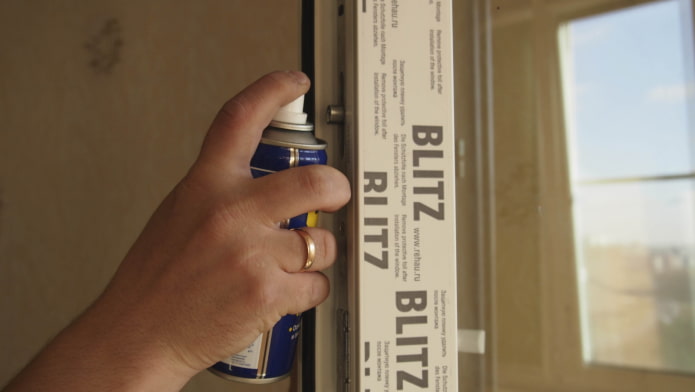
Adjusting fittings
Other problems that may arise during the operation of plastic windows are also solved by adjusting the fittings:
- The handle is loose. The adjustment is as simple as possible: move the decorative plate, tighten the fasteners with a key or screwdriver.
- The handle is jammed. If the handle does not turn in the open position of the window, simply press the lock located on the side end, put the handle in the desired position, release the lock. If the window is closed and does not open, try to press the sash tightly, especially in the upper opposite corner, and turn the handle in this position.
- Does not open completely or is difficult to open in ventilation mode. Put some grease on the “scissors” – the sash opening limiter.
- The sash touches the frame when opening or closing. The sash needs to be adjusted vertically and horizontally using the bolts on the hinges – see the detailed instructions in the section “How to adjust so that there is no draft?”
Wherever the problem occurs in the window, now you know how to fix the situation. But if the problem is serious or you doubt your abilities, it is better to contact a specialist.
Now reading:
- Three easy and effective ways to fix a cabinet hinge that has been torn out.
- Brown curtains: 97 stylish photos and ideas for window decoration in the interior.
- Explore the All-New BMW X3: Unleash Adventure Today!
- Blue curtains in the interior: 88 photos, styles, shades and combinations.
- 12 Ways to Decorate Your Room for a Birthday to Create a Magical Atmosphere